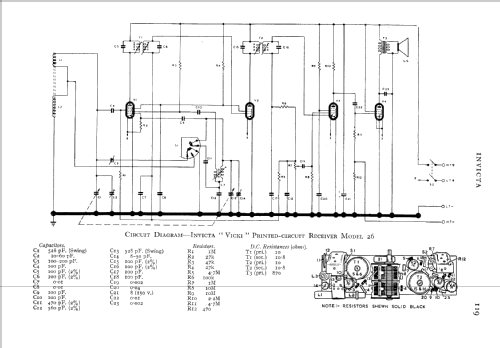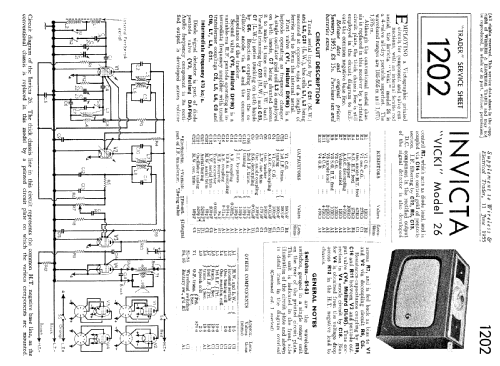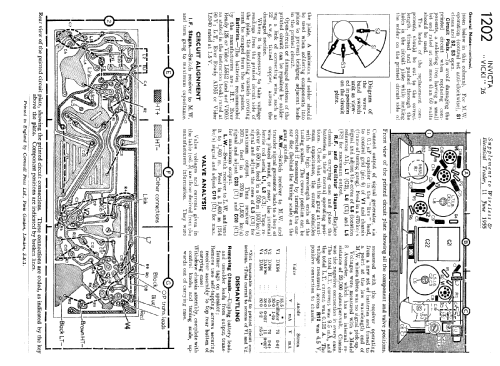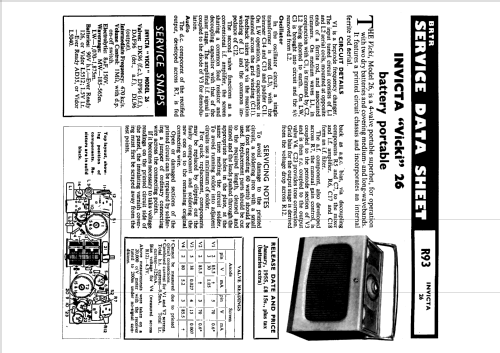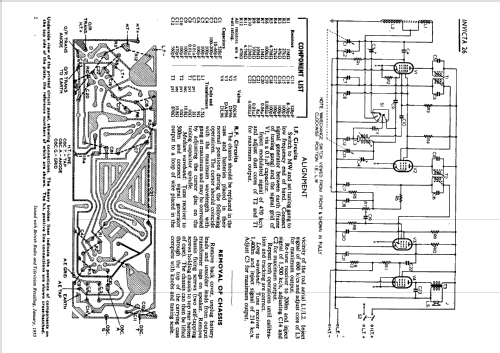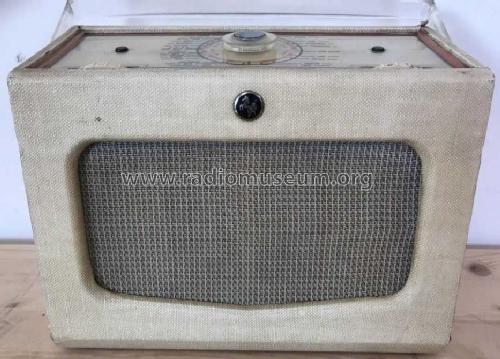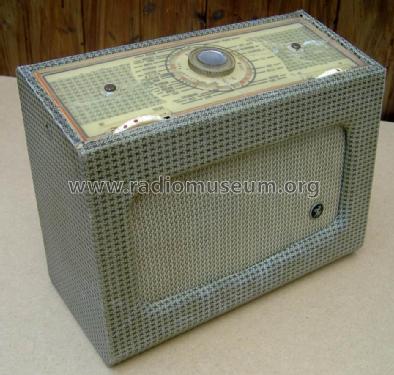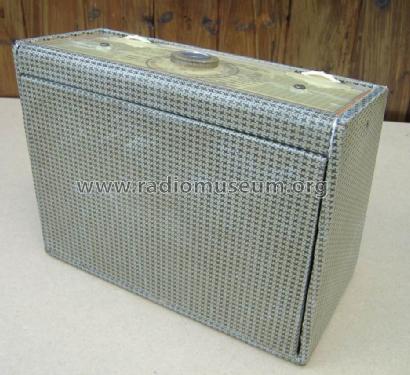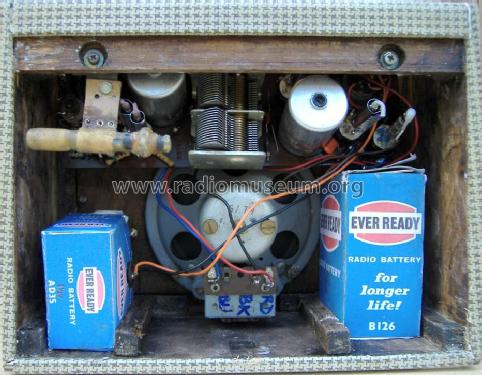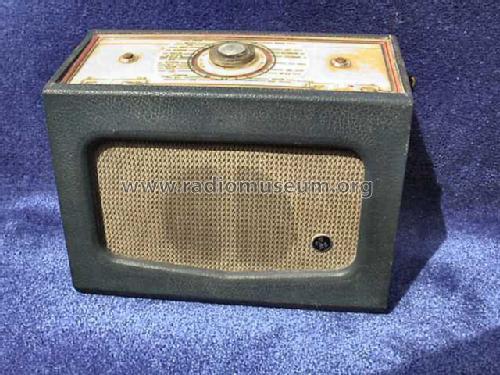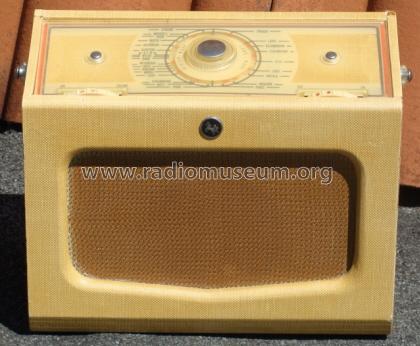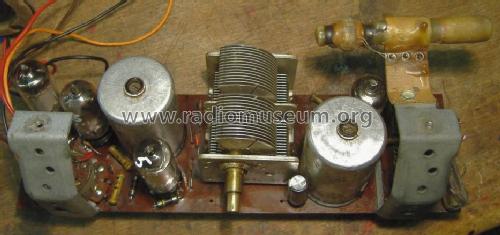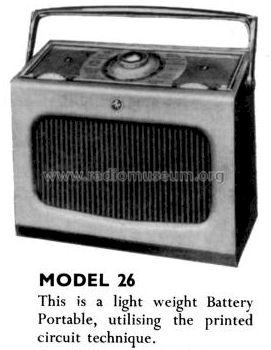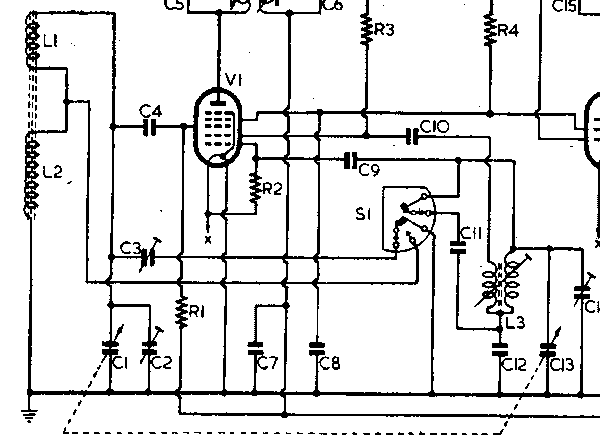- Country
- Great Britain (UK)
- Manufacturer / Brand
- Invicta Radio Ltd.; Cambridge, London
- Year
- 1955
- Category
- Broadcast Receiver - or past WW2 Tuner
- Radiomuseum.org ID
- 104789
Click on the schematic thumbnail to request the schematic as a free document.
- Number of Tubes
- 4
- Main principle
- Superheterodyne (common); ZF/IF 470 kHz; 2 AF stage(s)
- Tuned circuits
- 6 AM circuit(s)
- Wave bands
- Broadcast (MW) and Long Wave.
- Power type and voltage
- Storage and/or dry batteries / 1.5 & 90 Volt
- Loudspeaker
- Permanent Magnet Dynamic (PDyn) Loudspeaker (moving coil) / Ø 5 inch = 12.7 cm
- Material
- Leather / canvas / plastic - over other material
- from Radiomuseum.org
- Model: Vicki 26 - Invicta Radio Ltd.; Cambridge,
- Shape
- Portable set > 8 inch (also usable without mains)
- Dimensions (WHD)
- 270 x 215 x 128 mm / 10.6 x 8.5 x 5 inch
- Notes
-
Battery packs are separate Radio Battery B126 90V HT and Alldry Battery AD35 1.5V LT.
Unusually small Ferrite rod aerial for 1955 seems to work well. One piece perspex handle and one piece perspex top cover/scale.The Cossor Melody Portable 543 is the same chassis in slightly different cabinet, though backs interchangeable.. From before 1939, Invicta is merely a Pye "Brand".
Dimensions exclude handle and weight is without batteries.
PCB. Pye was an early adopter of PCBs compared to UK competitors.
- Net weight (2.2 lb = 1 kg)
- 2.2 kg / 4 lb 13.5 oz (4.846 lb)
- Literature/Schematics (1)
- Radio And Television Servicing books (R&TVS)
- Literature/Schematics (2)
- Trader Service Sheet (suppl. of Wireless & El. Trader, etc.)
- Author
- Model page created by Peter Hoddow. See "Data change" for further contributors.
- Other Models
-
Here you find 117 models, 68 with images and 82 with schematics for wireless sets etc. In French: TSF for Télégraphie sans fil.
All listed radios etc. from Invicta Radio Ltd.; Cambridge, London
Collections
The model Vicki is part of the collections of the following members.
Forum contributions about this model: Invicta Radio Ltd.;: Vicki 26
Threads: 1 | Posts: 3
Vicki or the Invicta 26 was a set I wasn't looking for. It was in a "job" lot and I was warned that it was very poor order. I could see some of the issues... I was told the perspex top all broken and case "some" woodworm. Well, it was one of a lot working out at £5 each including postage, what had I to lose?
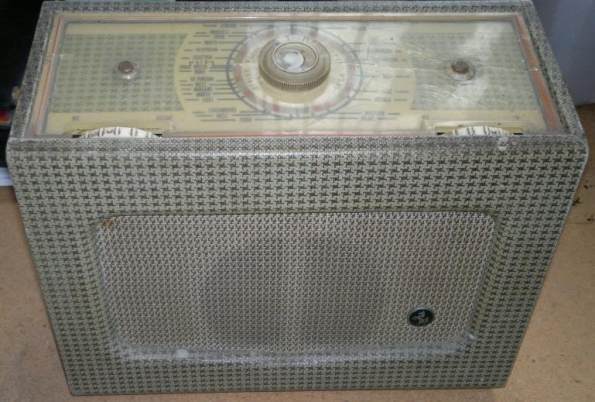
The original photo the seller sent. The perspex top is obviously badly cracked and handle missing.
Eventually the box of portables came (including an Ever Ready Sky Casket and Pye "Jewel Case" P114BQ). The Invicta range by 1950s is just actually a Pye marque. I was surprised that as well as being an Invicta 26 from 1955 that this Pye has an "official" name too, "Vicki".
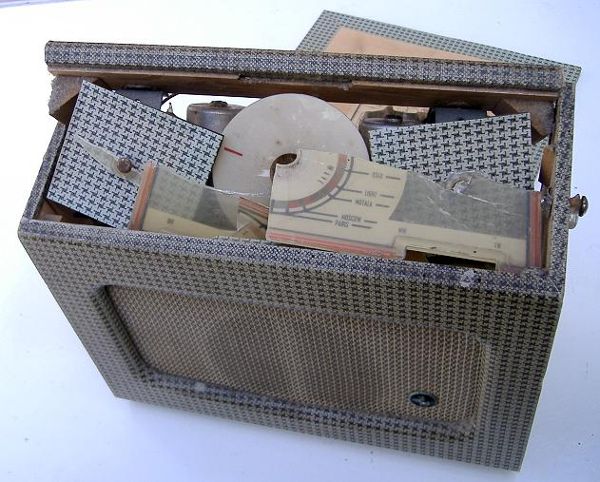
Vicki arrives to stay with me
I had the "bright" idea of soaking the case to get the Rexine / Leatherette off in one piece and then treat the VERY extensive woodworm.
Anyway, I never leave woodwormed stuff sitting. I deal with it at once. This this the first portable I've had with Worm. So no blowtorch. I decided to soak and peel off the covering and THEN I can blow torch the bugs.
After about 15 minutes I was able to peel of most of the the cloth. The glue is very like wallpaper paste. A further 20 minutes and the bottom came off.
Of course the glue for the joints is water soluble too!
Oh.. A Kit Radio by Ikea
The parts now neatly fit in the oven. 120C in the fan oven won't hurt the wood or the oven. But the bugs die at > +30C. I'll leave that a while to make sure they are cooked through.
Woodworm
Almost all "treatments" only stop re-infestation. None of the retail fluids actually kill live woodworm grubs effectively unless the wood is completely soaked for quite a long period. Unhatched eggs are likely killed as are possibly recently hatched grubs.
You can kill the woodworm by:
- Removing oxygen
- Poison gas!
- Heat greater than 30C
- Cold below -21C
- Drying wood below 11% moisture content
Known killing options are:
- Nitrogen or poison gas for several days in a warmed sealed environment
- Blowtorch on both surfaces, especially inside. Good if the varnish is very badly cracked or scraped.
- Soak in Paraffin. No doubt this drives out the oxygen and moisture? Probably other things like household heating oil, diesel, petrol, white spirit will work. Don't combine with Blowtorch!
- Bake in an oven. With good Fan oven it's likely that 100C to 120C is fine. length of time depends on thickness of wood. Only suitable for bare wood.
- A powerful freezer < 21C, several cycles, each a day or so
I use oven (and/or Blow torch on both sides of wood till lightly "toasted"). Then soak in Ronseal Total Wood Preservative or the equivalent Cuprinol. They will kill and prevent fungus and bacterial infections.
Borax solution is allegedly as good or better than Ronseal, Cuprinol or Rentokill treatments to prevent re-infestation. The commercial preservative fluids are quite flammable. Only apply AFTER cooking!
Keep treated cabinet indoors in a warm dry location where it can be seen regularly for about 5 years as from egg to flight hole is 3 to 5 years. If there are only old black holes looking really old there may not be any infestation (but you won't know for 3 to 5 years). If there are any fresh holes, especially with dust then beetles have hatched, probably mated and died. The adults don't eat and die in a few days. Infestation ONLY is from an adult beetle laying fertile eggs. These are laid in cracks, existing (now empty) flight holes or bare wood. So after treatment the filling of all holes and varnish all seams and barewood is helpful in reducing or blocking new attacks.
The Chassis
It's a PCB. Loads of Hunts brown brittle caps. Test the C22 aka "That Cap" the Anode of pre-amp (DAF96) to grid of output (DL96). High leakage. This could wear filament badly and burnout transformer so that you lose both...

C22 must have no measurable leakage.
ALL the hunts look like shorts on the Leakage tester
The DF96 is dead. No filament.No surpise, it died and saved the transformer, more common with DL96 than the x2 higher filament current DL91, DL92 and DL94
The Wavechange switch goes round and round. It's been forced and the contacts are all bent and one end stop bent
Some poking with pliers and screwdriver and it "seems" right.
Power... some motorboating... the electrolytic across HT is supposed to be 8uF and looks sick. Reads less than 2uF. Remember the o/p tube bias is a resistor in series with HT- so the decoupling on the bench PSU is no use. Replaced with a 16uF 350V part that's half the size.
Now dead.
We get a "buzz" touching top end of volume control, but only if the DAF96 is wiggled first. Clean all the sockets. They have corroded.
Still largely dead but howls at HF end of LW. Try Sig Gem. One IF has been twiddled. The MW & LW does respond to generator so just very deaf. Test replaced DF96 and original DK96 on borrowed VCM163. Both are OK.
A wire is broken at terminal of MW coil at Ferrite. Still poor. Check the 560pf & 470pF (C11 & C12) even though they are both Silver Mica.
They are OK. Check Alignment. C3 has no effect to Peak LW at HF end. Suspect switch.
Poke switch and howl stops. Able to tune RTE1 LW! So lever up spring, twist past contacts, bend all the the contacts (again) and clean centre arcs. Howl now gone and MW stations & R4LW working.
L3 is LF end of MW.
C1 is Osc padding to set HF end point on MW
C2 matches the RF tuning at HF end
THEN adjust only C3 on LW. (no separate Osc HF padding/tracking on LW)
C3 now peaks LW at 280kHz
Now R4 LW working and loads of MW stations (as it's after dark, none during daylight on an ordinary radio in Ireland).
Volume and quality isn't great. But could be because the speaker is loose on the bench? Next I'll test all my DL96s on the VCM163 and compare the Dx96 series with my plug in "franken" Rod Pentodes.
Michael Watterson, 03.Aug.12
